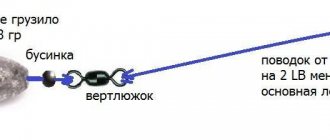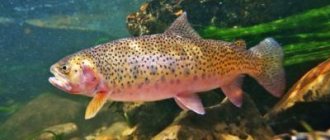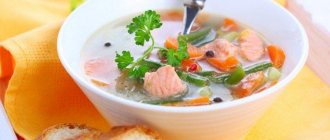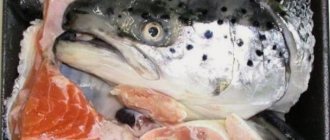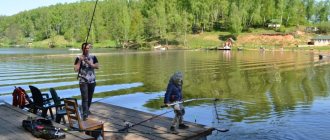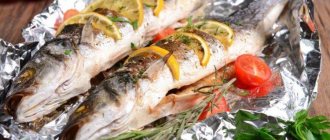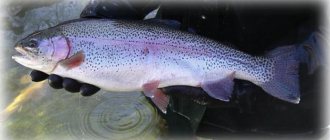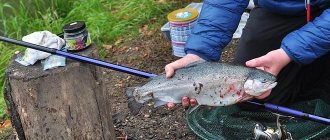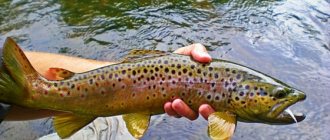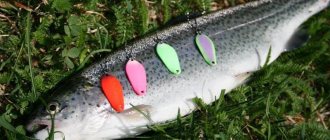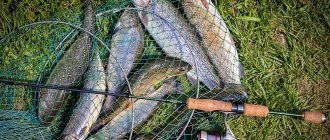Trout is known for its tasty and “precious” meat, for which not only experienced fishermen, but also beginners strive to try their luck and learn how to catch trout at any time of the year.
To catch trout, not only spinning rods are used, but also float/bottom gear. We recommend taking a closer look at special fishing pastes for bait. This is a %%currentyear%% trend. Fishing often takes place in paid water bodies, where even gear can be rented. They will also give you pasta, but we will recommend a homemade recipe that definitely deserves your attention.
What is pasta?
The structure of this paste includes various additives that have a bright color and aroma. The paste is available in small jars. Its consistency is closest to plasticine, so it can be used to make a nozzle of any shape. The paste is available in many fishing stores, and its price is quite affordable, so each fisherman has a choice - to make the paste himself or try existing options from different suppliers.
How to catch
Trout loves small fish, frogs, and roaches. Lake fish are often territorially attached to their habitat; when trout find food, they will drive away anyone who tries to get too close. She will choose a more favorable position and will hunt, trying to catch insects with her mouth, as well as small crayfish and various larvae that will be nearby in the water column. At the beginning of the year, even lake fish will never refuse fry and various small things. But for fishermen, there is nothing easier and easier to catch trout than paste.
Watch a video from a professional to learn how to fish more correctly.
The paste is brightly colored and has a very pungent odor, which is why it attracts trout very well. It is trout that prefers the smell of fish, caviar, cheese and garlic. It is best if the paste has glitter.
There are two types of bait - floating and sinking bait. Most often, trout are caught using floating bait, but in some cases the fish lies at a depth and then a sinking bait is needed. But it is not necessary to purchase every type. You can add a sinker to the floating bait, which will lower it to the bottom, this can be a lead ball or a piece of a sinker. Sinking bait can be lifted into the upper and middle layers using foam balls.
To catch this fish using pasta, no specialized gear is required; the following fishing rods are perfect:
- bottom
- float
- bombard
The bottom one makes it possible to cast a fishing rod farther and catch trout at bottom level. This fishing rod has:
- rod up to 3 meters with reel;
- nylon fishing line 0.26 - 0.28 mm is enough for 150 m;
- quick-release sinker;
- leash 1-1.2 meters from fishing line 0.20;
- hooks number 10 and 12;
For such a fishing rod, you can use both sinking and floating paste, but sinking is preferable.
Look at photos of rigs for bottom and other types of pasta fishing.
The float rod should have the following equipment:
- rod about 4 meters;
- nylon leash up to 0.6 meters;
- coil;
- hooks number 10;
- fishing line 0.25 mm long 100 meters.
This type of fishing rod is characterized by floating paste.
Installations for both bottom and float tackle are as simple as possible. Serial connection of elements.
Bombarda is characterized by a brass or lead sinker, which is located inside. The bombard should be transparent and less noticeable in the water. With it, it is advisable to do slow retrieving with short pauses, this way the bite will be better.
Features of fishing
When fishing for trout with paste, equipment plays an important role, but the time of year and weather conditions are equally important. In summer, the fish lies on the bottom, because it prefers cool places. In winter, adults are especially picky about food, their sense of self-preservation is heightened, so any careless movement can scare off the prey. For fishing to be successful, you should know in advance what bait, tackle, and fishing technique to use:
In winter, it is better to use bait with a strong aroma and attractive appearance. A paste with glitter and garlic flavor is suitable for this. If fishing is done from ice, then you should make several holes at once and fish them one by one. You can explore both the bottom and the upper layers of water, because the fish constantly wanders in search of food. If you bite or catch a trout in one of the holes, it is better to immediately move on to the next hole.- In early spring, the trout bite is at its peak. Catching a trophy specimen becomes easier if you follow certain spring fishing conditions. For fishing, it is better to choose places with rifts and gentle currents. At this time, the fish prefers to eat animal food. A pasta with a fishy or shrimp flavor would be an excellent choice. When fishing, use a slow, steady retrieve and floating bait.
- In summer, trout activity decreases. Catching her is quite difficult, but possible. To do this, in the summer it is better to use a bombard or donka, because the fish lies on the bottom in search of a cool place. You should look for trout at depth, in the shade, near underwater vegetation or trees. Sinking paste is used as bait, and the best time for fishing is early in the morning or evening.
- Autumn is the most favorable time of year for catching lake and river trout. In the autumn, this representative of the salmon family goes to spawn, so it leads an active lifestyle. You can catch a trophy specimen anywhere in a body of water. Any bait and tackle is suitable for fishing. In autumn, fisherman should not go into the water so as not to damage the eggs. On cold days there is almost no bite; it is better to go fishing when it gets warmer.
Putting pasta on a hook
A device for putting paste on a hook
Using paste for trout is very convenient, especially since these skills will be improved with practice.
- First, pinch off a small piece from the total mass and roll it out in your palm until it forms a ball the size of a pea.
- Then we immerse the hook so that it is completely hidden, otherwise the fish’s natural instincts may play out and it will be cautious.
- After this, give the paste an oval shape or leave it in the shape of a pea.
Another important and necessary device is a special mold, which is needed to give the bait the desired shape; it can also be purchased at the store.
Cheese recipe
Cheese paste showed tremendous results when fishing for trout. Let's figure out how to cook it yourself.
Trout pasta recipe from our editors:
- We take the required number of eggs depending on the amount of paste you want to get, beat them into a bowl of milk and do everything as when preparing an omelet.
- Mix everything thoroughly and pour into the pan without oil.
- Stir everything until all excess liquid has completely evaporated.
- Next we need trout feed; it can be bought at any zoological market.
- You also need to add cyclops and daphnia - a few glasses will be enough.
- Grind all this into powder and add to the previously prepared omelette.
- The main part of trout food is any cheese with a strong smell, add it to the resulting mixture.
- It is also advisable to add herring or sprat, after grinding it in a meat grinder.
- And the last ingredient will be canned corn, which also needs to be ground in a meat grinder, and the resulting juice added to the mixture.
- Mix everything thoroughly and the homemade cheese paste is ready.
Or buy ready-made PowerBait fishing cheese paste
Types of rigs for fishing with pasta
Using this bait, the angler has a fairly wide choice among the equipment of all kinds of rods for trout fishing. The undoubted leader is the use of float gear. The trout fishing rod comes with a standard set consisting of fishing line, float, sinker and hook. Depending on the fishing distance, both the length of the rod and the method of equipment are selected. Match and Bolognese tackle have advantages over the fly version due to the fishing range, where cautious fish are least at risk of being frightened by the careless actions of the fisherman. Similar float rigs are used when hunting for trout using a plug rod. For trout fishing, long gear, from 12 meters, is used. They are caught with a plug at feeding points along the daily migration routes of the predator. This type of fishing is confidently practiced in paid trout ponds, where the fisherman is very familiar with the topography of the reservoir, and the fish themselves are not as shy as in natural reservoirs, streams and backwaters of fast rivers.
Feeders or pickers are used as bottom gear. The fishing strategy is worked out without the use of feeders, using only a sliding sinker and a baited hook. The decisive importance of this type of equipment is designed to supply bait to the area of the reservoir, which is obviously known as a parking and feeding area for the predator. A classic bottom fishing rod, like an elastic band, also has the right to use pastes as bait. A distinctive feature of this type of fishing is the use of fluorocarbon fishing lines as leashes, making the rigs secretive and less noticeable to predators.
It has become common practice to equip fishing rods with auxiliary floats in the form of bombards. For this type of equipment, specialized fishing rods from 3.5 to 6 meters long have been developed, which are equipped with spinning reels and thin braided fishing line. Depending on the fishing conditions, floats of various types of depth are used, thereby ensuring an optimal fishing horizon. The wiring itself is carried out by uniformly winding the cord, without stops or pauses, provoking the fish to bite by the monotony of the movement of the bait and its strong smell.
In cold streams and fast-flowing rivers, fly fishing is used, using paste peas instead of flies. For camouflage, they are caught purely in a wade in the riffles and rapids of a reservoir. From ice to paste they cast jigs using winter spinning rods. As a load, jigs with hooks with an elongated fore-end are used. Spaced equipment is also used, where the shipment is made in the form of lead pellets.
Seasonal fishing
Trout behave extremely cautiously at any time of the year, and it takes effort to outwit it.
As warmer water begins to be added to the ponds, the trout will begin to become more active. The season for catching trout can be opened in March, because the fish begin spawning in the autumn. But you still can’t expect big catches, even though the ground is still frozen and the water is quite clear. In the spring, it is better to try to catch trout in those places where it overwintered, these are pits, inside of which there may be food for trout. But when the water level gets higher and the water becomes cloudy, it is quite difficult to find trout.
Now let's look at catching trout specifically by season.
In winter , fishermen need to be quieter than usual, because at low temperatures, fish digestion slows down significantly and trout eat much less than usual. In winter, it is best for the bait to have not only a pronounced smell, but also glitter, so there is a much greater chance that the fish will notice the bait. Where there is ice, it is best to fish from a new hole. And in areas where the climate is warmer, trout can be caught at all times of the year. At the end of winter, when the ice melts, the fish become more active, but the bite is still not very good.
In the spring. With the onset of the spring thaw, trout begin to move faster, but are not yet in a hurry to move away from the place in which they spent the winter. Trout are located where the current is weak, and this is where their food lives - small fish and frogs. At a time when the water becomes cleaner and the snow completely melts, trout become active in biting. But it begins to swim to the shore in mid-spring, when insects appear. This will be the ideal time for pasta, because the fish is full and if it wants to chase something, it will only be a good aromatic piece of cheese paste.
In summer, trout fishing is suitable for those fishermen for whom fishing is more a process of pleasure than result. Since the trout is far from the surface of the water and the shores, it tries to hide from the heat all the time, and hunts more at night. The only option would be to catch trout in the early morning, when it has eaten, but has not yet hidden to the bottom. Then it is better to go fishing with plug and fly rods, but you must act very carefully so that the trout does not get scared. For the same reason, it is better not to use boats.
Autumn fishing is the most successful. The fish begins spawning and begins to behave very aggressively, and it will not be difficult to catch it either at depth or far from the shores. Trout rushes to any bait and gains its weight. Trout paste is perfect for autumn fishing; trout will not hesitate to swallow a piece of paste, which smells very appetizing. Do not forget that there is a high risk of damage to the caviar, so it is better not to go into the water.
Fishing for trout with pasta in winter and summer
Trout is a rather cunning and cautious fish. It is difficult to outwit it at any time of the year, and catching trout with pasta in winter is a real test of intelligence and patience. At this time of year, fish react especially sharply to any irritants. Any careless movement or sound - and the fish swims away. It is impossible to predict where it will end up - at the bottom or on the surface.
At the same time, regarding food, the fish behaves very passively. At low temperatures, her metabolism slows down, she eats less and hardly moves. The fish reacts very sluggishly to bait, so you need to choose a paste with a very strong smell and preferably with glitter. You can also combine it with a moving bait.
In warm regions where the water does not freeze in the winter, trout can be caught all year round. Unless, of course, it is prohibited by law. When fishing on ice, it is advisable to fish from a new hole each time.
The fish become somewhat more lively at the end of the cold season, when the ice begins to melt. However, catchability during this period of time is quite low.
Trout paste is one of the most common and frequently used baits for trout fishing. It earned its popularity for a reason - the paste provides an excellent catch at almost any time of the year.
Some enthusiasts prepare pasta according to their own recipe, using mainly dough, all sorts of aromatic additives and perhaps some branded ingredients. Most fishermen buy pasta because it is quite cheap.
Where do trout live?
The main strategy for catching trout is to find a good fishing spot.
Unfortunately, knowledge of all the reservoirs in which trout live is not the key to successful fishing. To achieve results, it is important to know accurate data, those that can only be found out on your own by trying to fish in different places in water bodies. It would also be a good idea to ask experienced fishermen who are very familiar with the area. Mostly fish live in large reservoirs, lakes and rivers, or rather in whirlpools, rapids, under places close to bridges. In mountain and forest rivers and streams it is found in whirlpools. When danger is detected, it can swim under tree roots and large rocks. This is mainly a cold-loving fish species, and most often chooses very cold sources and depths.
Many trout live in Norway, where specialized fishing and tourism centers have been created that specialize specifically in trout. The USA is famous for sport fishing, in which the main object is trout. In countries where a huge number of mountain rivers predominate, trout occupies one of the leading places. Trout is found in Lakes Onega and Lake Ladoga, where the water is cold and clean. Brook trout is found in a large number of mountain and forest streams, where the water is most enriched with oxygen. There are also river trout in the Crimea and the Caucasus. Trout weighing 300-500 grams is more common, but sometimes weighing 1-2 kg.
Flashing techniques
Our task is to fish all layers of water. First - superficial. The basic technique looks like this: I lower the lure 50 cm, smoothly lift it with a fishing rod almost to the ice and smoothly lower it again. Moreover, WILLIAM'S Wabler, even on the rise, oscillates slightly, its edges sparkling. Then there is a delay until the line is tensioned and the “irritating” cycle is repeated - a total of 3 times. Here I deliberately do not allow a free fall, so that the spinner does not “reveal all its trump cards” ahead of time. There are no bites at this stage, but it seems to attract and “excite” the fish.
And here is the decisive moment - I sharply lower the fishing rod, and the spoon goes into its chic free fall, first deliciously moving to the side, then gradually returning to a vertical position on the line. If there is already an “excited” fish nearby, then it often cannot tolerate such an unexpected maneuver - and then the long-awaited blow is delivered to the hand! Eat! Eat!! Eat!!!
Caught the bait, beauty!
It is clear that such a technique did not come from heaven, but was developed through trial and error. And here it is the complex irritating-provoking presentation of bait that is the main key to success. It is clear that the neighbors will immediately “copy” a successful lure, but this will not bring much success until they understand all the nuances of playing with bait. It seems to me that some movements only attract and irritate the fish , but only special techniques - as a rule, sharp deviations of the spoon from the usual rhythm - actually provoke the predator to grab. Once you understand this basic rule, you can eventually come up with other successful game techniques.
For example, during the attracting phase I often almost lift the spoon into the hole. The trout are probably curious when the bait will finally rise completely. And she suddenly dives down sharply and goes to the side. Ku-u-uda???
Don’t forget about the neighboring sizes - sometimes it doesn’t bite on the “forty”, but it does bite on the “thirty” or “fifty”. And sometimes, the fish clearly like lures with an embossed surface. But all these squabbles are only within the family. In terms of catchability, WILLIAM'S is a champion! We persistently tried other lures, including equally famous ones - not the same! That's not how they play! Doesn't bite! By the way, we also tried a balancer, but in 30 fishing trips, only 2 trout were caught on the “horizontal” one.
Favorites from WILLIAM'S
After fishing the sub-ice layer, I move on to similar manipulations at mid-water. And if there are still no bites, I lower the bait to the bottom.
Bottom trout trolling has its own subtleties. Unlike fishing with paste, the spoon must reach the bottom. Here’s my favorite technique: I make a plumb line so that when returning to the vertical, the bait barely touches the ground. Then I sharply lower the fishing rod by 3-5 cm - the spoon wags to the side, as if trying to burrow into the soft bottom suspension of silt - and here it is, a bite! Another good option is if there are no bites, I place the spoon on the bottom for 1-3 seconds, and then slowly lift it 5-10 cm from the bottom, as if the observed prey is trying to escape... Whoa-oh-oh! And again the bite!
Great shape! This trout was clearly swaying, but that didn’t save it.
By the way, the trout bite cannot be confused with anything. Even from a depth of 6m, the blow is transmitted so clearly that there is no doubt - this is the “winter queen” again! The hook follows automatically and the next fish, “cutting circles”, begins to feed slowly... The clutch is tightened, otherwise you won’t be able to hold the fish. However, he walks briskly. The fishing rod is thrown to the side and, fingering the fishing line with my hands, I forcefully lift the beauty to the surface. Wow! Nimble - don't yawn. Otherwise, the line will break or the hook will be pulled out. Right through it! Not quite “boring”, but persistent! Neat but dynamic! There will still be some kicking around the hole, but we’ll still take it on the “post”! If you're lucky!
The secret of catchy pasta
Some fishermen believe that the effectiveness of the paste is not so great, but most often this is due to its improper use. There are some subtleties when fishing for trout:
- Under no circumstances should paste be frozen, and in winter it is best to keep it near the body, otherwise it may lose half of its qualities in the cold.
- To prevent the trout paste from disintegrating during casting and upon contact with the surface of the water, you must first press it down well with your fingers.
- The chances of a successful catch increase in proportion to the amount of bait (the more, the better, of course). Trout can eat an amount of food equal to a second third of its weight, so in this case it is better not to skimp.
Fishing for trout with pasta in winter and summer
Summer is the least favorable time for fishing with pasta. Trout always hide from the heat far from the shores and surface, and come out to hunt only at night. You can, of course, approach by boat, but most likely the fish will get scared and swim away. At night she has enough prey. You can catch trout using pasta only in the early morning, when it has already had its fill, but has not yet sunk to the bottom.
It is much more effective at this time to fish using fly rods and plug rods. But at the same time you need to have sniper casting accuracy. And cast very gently so as not to scare away the fish.
Fishing with pasta in the summer is suitable only for those who value the process of fishing, and for him the catch is a secondary matter.
